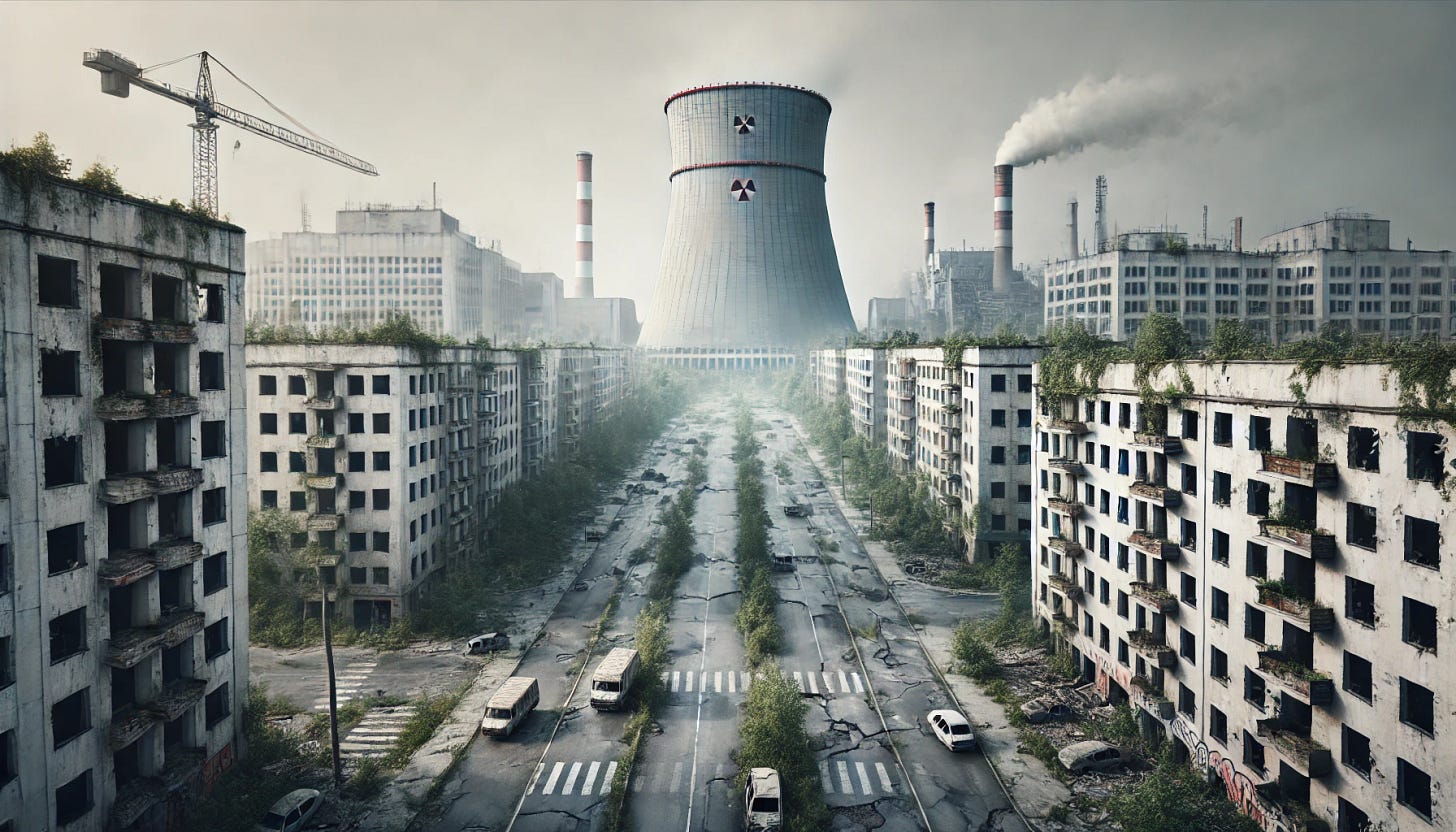Preparing for Collapse is Necessary, Especially for the Planet
Introduction to Collapse Part III - The Future
Is there any hope for humanity and the immediate health of the global biosphere? I don’t believe anyone really knows for sure. But I think it is a topic worth exploring for a number of reasons. How we respond may be the difference between total ecological destruction, and a future where life continues on the planet, even if that does or doesn’t include humans.
(Author’s Note: I’m going to make this very brief so its digestible as an introduction to the topic. The evidence is embedded in the source material. Stay tuned for more in-depth articles)
See also Part I and II of this series:
While I don’t believe in the false hopes sold to us under the banners of capitalism, technology or any effort to maintain the status quo, I do believe there are really bad outcomes and there are even worse outcomes still possible in the future. While the better outcomes are riddled with their own challenges, I believe it is still worth trying for better than worse.
What path we go down largely depends on how we react to the various stages of collapse. Collapse isn’t a doomsday event that wipes out everything in a day… usually. It’s typically taking place over several decades. Some even suggest we are already in an early stage.
So let’s talk about these stages of collapse, what sort of reasonable responses might occur to mitigate them, and then what sort of walls we might expect to hit where the future of humanity and the biosphere would seriously be in question.
The 6 Stages of Collapse
Of the many writings on collapse, I find Dmitry Orlov’s book, The Five Stages of Collapse, A Survivors Guide particularly useful in providing a concise framework. I should note that Orlov also later wrote in a blog post stating that he had initially failed to recognize a sixth stage of collapse. This stage is without question the most important and scary, as we will see.
I am going to relay these stages to you very briefly. Reading Orlov’s book will give you a more in-depth analysis, should you want it.
Stage 1: Financial Collapse:
Loss of faith in financial institutions and systems.
Banking failures, currency devaluation, and the inability to service debts.
Stock markets crash, leading to asset devaluation and capital shortages.
Stage 2: Commercial Collapse:
Breakdown of supply chains and market-based systems.
Scarcity of goods, including food, medicine, and fuel, as imports and retail networks fail.
Commercial entities, especially large corporations, can no longer operate effectively.
Stage 3: Political Collapse:
Loss of faith in government structures and their ability to provide order or basic services.
Governments become ineffective or authoritarian, leading to lawlessness or state crackdowns.
Social unrest and power vacuums form as political institutions disintegrate.
Stage 4: Social Collapse:
Breakdown of social structures and community bonds.
Families, charities, and mutual aid groups disintegrate under pressure.
Trust erodes, leading to a survival-of-the-fittest mentality.
Stage 5: Cultural Collapse:
Complete loss of belief in the goodness or future of humanity.
Society descends into selfishness, violence, and a breakdown of moral values.
Cultural identity and ethical systems crumble, leading to widespread despair and nihilism.
Stage 6: Environmental Collapse:
Natural systems like forests, oceans, and freshwater sources collapse due to pollution, deforestation, and climate change.
Rising temperatures, extreme weather, and rising sea levels make large areas uninhabitable.
Scarcity of essential resources like freshwater, arable land, and energy leads to food and water shortages.
Unmonitored nuclear and toxic industrial sites cause further contamination and environmental hazards.
What Stages We Can Respond To?
Preparations for Stage 1:
This includes recognizing the fragility of financial assets and looking towards more tangible forms of value, such as food, energy independence, and community resilience. Rather than trying to prevent financial collapse, which may be futile, it is suggested to focus on building local resilience through tangible resources that are less susceptible to the failures of the global financial system.
Key categories include:
Food Security: Invest in growing your own food or supporting local agriculture through community gardens, permaculture, or small-scale farming. Stockpiling non-perishable foods and learning preservation techniques like canning or drying are also valuable.
Water: Ensure access to clean, renewable water sources. This could include installing rainwater collection systems, digging wells, or securing nearby natural water sources.
Energy Independence: Shift towards renewable energy sources such as solar panels, wind turbines, or other off-grid solutions. Energy storage, like batteries or generators, can ensure you have power when traditional grids fail.
Shelter and Heating: Strengthen your home’s insulation, and explore alternative heating options, like wood stoves, that don’t rely on external energy suppliers.
Tools and Skills: Acquire tools for gardening, building, and repairing, along with learning essential skills like carpentry, first aid, and mechanical repair. Having the knowledge and equipment to maintain self-sufficiency is vital.
Local Networks and Barter: Build strong community ties to facilitate resource sharing and bartering. This creates local economies independent of collapsing financial systems and increases access to resources like labor, knowledge, and goods.
Medicinal Supplies: Stock up on essential medicines, first aid, and learn herbal remedies to reduce dependence on pharmaceutical supplies, which could become scarce during financial collapse.
Preparations for Stage 2:
To prepare for Commercial Collapse, you should focus on:
Food and Water Independence: With the collapse of supply chains, growing your own food or creating local food networks is essential. Develop water collection systems or secure access to clean water sources, as municipal supplies may become unreliable.
Alternative Trade Systems: Bartering will likely replace currency in many cases. Strengthen relationships in your community to facilitate mutual support and create barter systems for essential goods.
Essential Skills: Learn practical skills, such as gardening, basic healthcare, and mechanical repairs, to reduce dependence on external commercial systems. These skills will be valuable in trade or self-reliance.
Local Production: Support or create local manufacturing of essential items, like clothes, tools, and medicines. Developing local production systems will help communities become more resilient as global trade falters.
Energy Sources: With fuel shortages looming, alternatives like solar, wind, or human-powered tools (e.g., bicycles) will help reduce dependence on commercial energy grids.
Preparations for Stage 3:
Tangible resources and strategies for preparing for political collapse focus on self-governance, defense, and community resilience:
Self-Governance Structures: Build or join local, decentralized governance systems like neighborhood councils or cooperatives. These should emphasize direct democracy and mutual aid, allowing for collective decision-making when the central government fails.
Defense and Security: Ensure the security of your community, especially as law enforcement systems become unreliable. This may involve local defense groups, communication systems, and developing conflict resolution skills to maintain order.
Energy and Food Security: Continue strengthening local, independent energy and food systems since governmental distribution of these resources may become erratic or disappear. Establishing renewable energy solutions and local food production networks are critical.
Information and Communication: Secure independent communication systems. Political collapse often results in censorship or propaganda from weakened governments, so having alternative channels like community radios or encrypted online networks can keep people informed and coordinated.
Legal and Health Alternatives: As government-run systems break down, communities will need alternatives for legal disputes and healthcare. Investing in local mediation for conflict resolution and developing basic health networks, including herbal medicine and first aid, will reduce dependence on failing institutions.
Preparations for Stage 4:
To prepare for Social Collapse, focus on strengthening local networks and building resilience:
Local Community Networks: Strengthen relationships with neighbors and local groups. Create systems of mutual aid that are robust and decentralized, allowing for survival even when larger systems collapse. Sharing resources and skills in trusted, localized communities is crucial.
Diversified Resource Pools: Organize local cooperatives that produce food, generate energy, and provide essential services. This can alleviate pressure on fractured institutions and reduce dependency on external systems.
Conflict Resolution and Leadership: Train individuals in conflict resolution and community leadership to prevent internal strife. Ensuring that communities can handle disputes peacefully and with minimal resources is key to long-term survival.
Cultural Adaptability: Foster a shift in values and expectations within communities, embracing a simpler, more sustainable way of life. As traditional social systems break down, adapting to a culture of cooperation and reduced materialism will ease the transition.
What Stages Are Mostly Untenable?
In the process of societal collapse, the stages tend to cascade, with each failure leading to the next. While stopping the collapse early on (at Stage 1 or Stage 2) is often futile due to the overwhelming systemic issues, digging in at Stage 3 or 4 is both feasible and crucial for survival.
Stage 1 (Financial Collapse) and Stage 2 (Commercial Collapse) are largely untenable points to stop the process. Financial systems and global supply chains are interconnected and fragile, meaning efforts to restore them often fail as they collapse under their own weight.
Stage 3 (Political Collapse) represents a critical juncture. In some cases, like the Soviet collapse, governments have managed to retain enough authority to avoid further breakdown into warlordism or complete anarchy. In localities with nuclear or industrial hazards, it is especially vital to prevent this stage from escalating, even if it requires extreme measures, such as international intervention.
Stage 4 (Social Collapse) is still manageable but deeply challenging. Stopping the breakdown of community bonds is crucial for maintaining a livable society. Sparse populations in impoverished areas might still survive at this stage, but Stage 5 (Cultural Collapse) must be avoided at all costs.
Once Stage 5 (Cultural Collapse) is reached, societal disintegration becomes untenable, with the loss of shared values and human decency, making recovery nearly impossible. Preparing for Stages 3 and 4 is practical, but preparing to survive Stage 5 is a bleak and demoralizing prospect. Thus, the goal should be to stop collapse before reaching the irreversible damage of cultural breakdown.
Why Stage 6 Presents the Biggest Challenge
Stage 6: Environmental Collapse represents the most difficult and dangerous stage of societal breakdown because it involves the irreversible degradation of the planet's ecosystems. This stage not only undermines human survival but threatens all life on Earth, making it uniquely catastrophic in comparison to earlier stages of collapse.
Irreversibility of Ecological Damage: Once ecosystems are destroyed—whether through deforestation, biodiversity loss, pollution, or climate change—they cannot be easily restored. Unlike financial or political systems, which may eventually be rebuilt, the loss of critical environmental systems like clean water, fertile soil, and a stable climate is often permanent. This makes recovery from Stage 6 collapse fundamentally different and far more challenging than from previous stages.
Global Consequences: Environmental collapse is not confined to local or regional scales. The impacts of rising temperatures, sea-level rise, and extreme weather events are global, affecting every society on the planet. This interconnectedness means that no community or nation can fully insulate itself from the consequences of environmental collapse, making it a challenge that transcends borders and requires collective action.
Dependence on Ecosystem Services: Human survival (as with other life) depends on essential "ecosystem services" such as clean air, fresh water, food production, and climate regulation. As highlighted in the essay, these services are irreplaceable, and their loss would lead to widespread starvation, water shortages, and a breakdown in human health. Unlike earlier stages of collapse, where communities might still survive by shifting to local production or alternative systems, Stage 6 leaves no viable alternatives if the planet’s life-support systems fail.
Industrial and Nuclear Hazards: Environmental collapse also exacerbates the risks of dangerous industrial and nuclear accidents, as unmonitored nuclear plants and toxic industrial facilities could lead to further devastation. Unchecked industrial collapse can cause long-term radioactive contamination, making vast regions uninhabitable.
Uncertainty of Solutions: The most daunting aspect of environmental collapse is that no clear, definitive solution exists. While efforts to mitigate climate change and reduce industrial pollution are ongoing, the sheer scale of the problem, combined with the complexity of global ecosystems, makes it difficult to predict how or if humanity can reverse the damage. Solutions may require extreme measures, but without immediate action, collapse could progress beyond the point of recovery.
Prepare Ye
Our goal then is to prepare for the earlier stages of collapse enough to prevent a total meltdown of the ecology. That’s why the preparing is so crucial, if not to preserve humanity, to at least prevent a total global ecological catastrophe at the hands of our toxic hazards. We have a duty to keep our shit together enough to stop the nuclear plants from completely destroying the planet.
So I did the best I could here to give you an introduction to this topic. I hope it is useful as a guide for future study and action. Here at the Collapse Curriculum, it is our mission to provide you with as much information and tools that you can become part of the solution, rather than a bystander waiting for the end. Thanks for reading.






Since all i do is grow food and herbal medicines for “fun”, I was heartened that this survival topic kept coming up in your piece. My front yard garden is my dystopian contribution I guess.
What a time to be alive